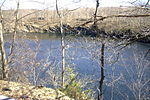Reed Memorial Library
Buildings and structures in Putnam County, New YorkLibraries on the National Register of Historic Places in New York (state)Library buildings completed in 1914National Register of Historic Places in Putnam County, New YorkU.S. Route 6

Reed Memorial Library is located at the junction of US 6 and NY 52 in Carmel, New York, United States. It is the oldest library building in Putnam County, and was listed on the National Register of Historic Places in 1980. It was built in 1914 by Arietta Crane Reed as a tribute to her late husband, William Belden Reed, an ardent supporter of the Literary Union of Carmel, which operates the library. It is a Tudorbethan-style building of local stone with marble accents, and much original period furnishing inside.
Excerpt from the Wikipedia article Reed Memorial Library (License: CC BY-SA 3.0, Authors, Images).Reed Memorial Library
Brewster Road,
Geographical coordinates (GPS) Address Nearby Places Show on map
Geographical coordinates (GPS)
| Latitude | Longitude |
|---|---|
| N 41.421944444444 ° | E -73.678055555556 ° |
Address
Brewster Road 1733
10512
New York, United States
Open on Google Maps









